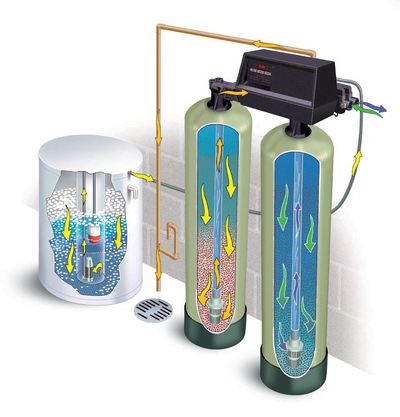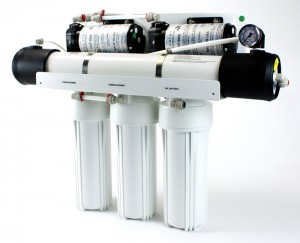

Special Mid-Month Issue
Income Tax Day, April 15, 2013

Read the Pure Water Gazette online. "Vast piles of information about water in theGazette's tangy, irreverent style." --Dallas Times Herald.
We hope you'll read the Pure Water Gazette's "Today's Top Water News" section. New articles appear daily. Some examples of recent posts are included in his issue
More from the Pure Water Gazette.
Sprite shower filters make you sing better.

An extensive (and expensive) WQA-funded research project indicates that well-tuned, efficient modern water softeners seem to be good for home septic systems, but older, less-efficient softeners degrade the performance of home septic tanks. In general, metered softeners are more efficient than timer models when they are correctly programmed. The twin softener pictured above, controlled by an electronic meter, is most efficient of all. Read all about the WQA research in the Pure Water Gazette.
Between small reverse osmosis units that reside under kitchen sinks to provide drinking water and "whole house" RO units large enough to supply the needs of an entire residence, there has always been a need for a mid-sized system to fill special needs.
If the owner of a small greenhouse, for example, wants enough high quality water to fill a tank to mist his orchids and another tank for general use, it is handy to have a small but powerful reverse osmosis unit that can keep the tanks full and the plants happy.
If the owner of a small portable window washing business needs to fill his truck's tank at night while he's asleep with enough low-TDS water to keep his customers' windows spot free, a compact but powerful reverse osmosis unit is a great thing to have.
If the owner of a small manufacturing plant wants to provide plenty of excellent water for the break room and kitchen area and have enough left to allow his employees to fill their water bottles, an efficient, trouble-free mid-sized reverse osmosis unit can fill his need at a relatively small cost and with little upkeep.
If the owner of a larger home wants to send excellent drinking water to his kitchen sink, to his bar, to an icemaker, and to an upstairs bathroon, a compact but powerful mid-sized RO unit is just what he needs.
Then there are those who want to fill a small outdoor pond or an aquarium with fish-friendly water, small-scale water vendors, restaurant and health food store owners--in short, anyone who needs a hundred or two gallons per day of top quality water--all of these will benefit from having a good mid-sized RO unit.
The Axeon LT300 is a compact but powerful reverse osmosis unit capable of putting out 15 gallons per hour of highest quality water for drinking or a variety of other uses. The LT300 can be used for small greenhouses, spot-free car washing, aquariums and fish ponds, window washing businesses, cleaning solar panels, coolers, humidifiers, small water vending enterprises, and much more.
It can be used with a traditional reverse osmosis pressure tanks, with non-pressurized holding tanks, or with no tank at all if a large flow rate isn't required.
The unit is ideal for a large home with high water demand, with plenty of water pressure and capacity to furnish not only drinking and cooking water, but multiple refrigerators, ice machines, etc.
The Axeon LT300 is an ideal unit for small businesses, making enough water to service a modest kitchen and lounge area and even to provide laboratory quality water for special functions like an in-house test lab or pharmacy.
The two "continuous duty" pumps are capable of around-the-clock service if large quantities of water are needed.
Here are some of the LT300's features:

The Axeon LT300 RO unit produces 300 gallons per day of top quality water that can be used for a variety of purposes. The LT300 comes fully assembled--ready to use. You need only a water source, access to a drain, a storage tank, and a 110 volt electrical source.
The Axeon LT300 is available from Pure Water Products for only $995--shipping included to lower-48 addresses. Pure Water Products also stocks all parts and replacements and provides phone support for installation and upkeep. It's coming soon to our main website, but in the meantime you can order by phone at 940 382 3814.

Rain Gardens are natural water savers that enhance the beauty of homes and serve as natural filters for polluted water. Is it a good idea to grow edible plants in rain gardens, since they will be watered with polluted urban stormwater? Australian researchers are working on the answer.
Rain gardens are now a common sight in many cities, but finding the right mix of plants to include in a rain garden can be challenging. For the people whose homes or businesses they occupy, the plants’ attractiveness is usually a priority. In some areas, you need to make sure the plants can withstand dry spells; you don’t want to end up irrigating your rain garden.
It’s been suggested that rain gardens be used to grow vegetables, and at first glance this seems to be a good two-birds-with-one-stone solution: growing something useful with a resource we’ve saved from going down the drain. But some have raised an alarm about the dangers of eating what we’ve irrigated with urban stormwater. One purpose of a rain garden or bioswale, after all, is to help filter pollutants from runoff; in high-traffic urban areas, pollutants might become concentrated in the soil, and plants uptake many of them, so do we really want to eat what grows there?
Yes, some Australian researchers say, we do. An ongoing experiment at the University of Melbourne is using roof runoff to irrigate two rain gardens planted with vegetables. Two conventional vegetable gardens—irrigated from the public water supply—are located nearby, and all four are heavily monitored.
In fact, the researchers say, nutrients that commonly enter runoff from landscape fertilization are actually beneficial to the plants. And other pollutants like metals haven’t been a problem so far; according to one researcher, “The filter layers in the rain garden are also doing their work by preventing heavy metals from urban water runoff entering our waterways, while also remaining at safe levels in plants. In contrast we revealed that crops irrigated by tap water actually contained higher levels of copper due to the pipes used.”
Granted, the Melbourne experiment is using roof runoff rather than street runoff as the source of irrigation. But it’s this type of experiment—rather than speculation or guesswork—that we need to see more of.

How Reverse Osmosis Tanks Work and How to Take Care of ThemBy Pure Water AnnieGazette Technical Wizard Pure Water Annie Clears Up the Persistent Questions about Reverse Osmosis Tanks That Have Been Keeping You Awake at NightA reverse osmosis tank is simply a miniature well tank. Pressure tanks on wells and RO tanks work the same way.Water enters and leaves the tank through the same tube.Inside the tank is a bladder made of a material called butyl. Water does not touch the metal or plastic shell of the tank. It touches only the butyl bladder and spout (usually stainless steel or hard plastic) as it enters or leaves the tank.
There is a small air charge between the outside of the bladder and the inside of the tank. It’s the air pressure that pushes the water out of the tank when you open the faucet.
When you purchase an RO unit or a new tank, the tank is usually pre-charged with air. But tanks are like automobile tires: you have to put air in them as part of normal maintenance.
The air valve to check the pressure is located on the side or on the bottom of most RO tanks. It has a cap like an auto tire air cap.The standard air charge for undersink RO tanks is about seven psi when there is no water in the tank. You have to empty the tank of water in order to check the air pressure.
To check the pressure accurately, you need a low pressure air gauge. You can find these at auto parts stores or hardware stores. To add air to the tank you need a high tech tool called a bicycle pump. These are also available at hardware stores.
Putting too much air in the tank will not give you more pressure at the faucet; it will just give you less water in the tank.
Servicing Reverse Osmosis TanksTo add air to the tank, turn off the inlet water to the unit, open the ledge faucet and let all the water run out of the tank. The valve on the tank must be open. When the tank is empty, attach a bicycle pump to the air valve on the tank and slowly pump in air. Water should come out of the faucet. Pump until no more water comes out, then check the pressure with a low pressure tire gauge. Leave about 7 psi in the tank when no water is in it.
You can add storage capacity to your RO unit by simply teeing two standard tanks together. They don’t have to be the same size.
RO tanks are interchangeable. You don’t have to replace the tank on your RO unit with one of the same brand or same size.
If you want more capacity, it’s usually easier and more economical to use two (or more) standard-sized tanks rather than a large tank. To join two tanks, all you need is a single tee and some tubing. The orange tube in the picture connects the tanks to the RO unit. The tanks don’t need to be the same size or the same style. They will interact perfectly together.
Some of the tank’s inner capacity is taken up by air and part is taken up by the bladder. Therefore, for practical purposes, the stated volume in gallons of the tank is about twice what the tank will actually hold in terms of usable water. You’ll get about two gallons of usable water from a four gallon tank. This will vary according to your inlet water pressure, the temperature of the water, the condition of the membrane and prefilter of your RO unit, and a few other variables. But don’t expect four gallons of water from a four gallon tank. On the other hand, two gallons is a lot of water unless you’re filling an aquarium or hosting a dinner party for 18.Metal tanks and plastic tanks yield water of equal quality. Plastic tanks are heavier and cost more than metal tanks, as a rule. The main advantage of plastic tanks is that the do not rust. Normally, metal tanks don’t rust if you keep them dry.
A tank valve is an essential part of the RO unit, although many cheap RO units are built without a tank valve. Without a tank valve, it is necessary to empty the tank to do a minor repair on the RO unit. The valve allows you to isolate the tank from the rest of the RO unit. This is a great advantage when you perform routine maintenance or service on the RO unit.
Source: Pure Water Products.
Early April Water NewsBelow are links to this month's postings on the Pure Water Gazette's "Top Water Story Section."
|
| | Powered by YMLP.com | |
| | ||